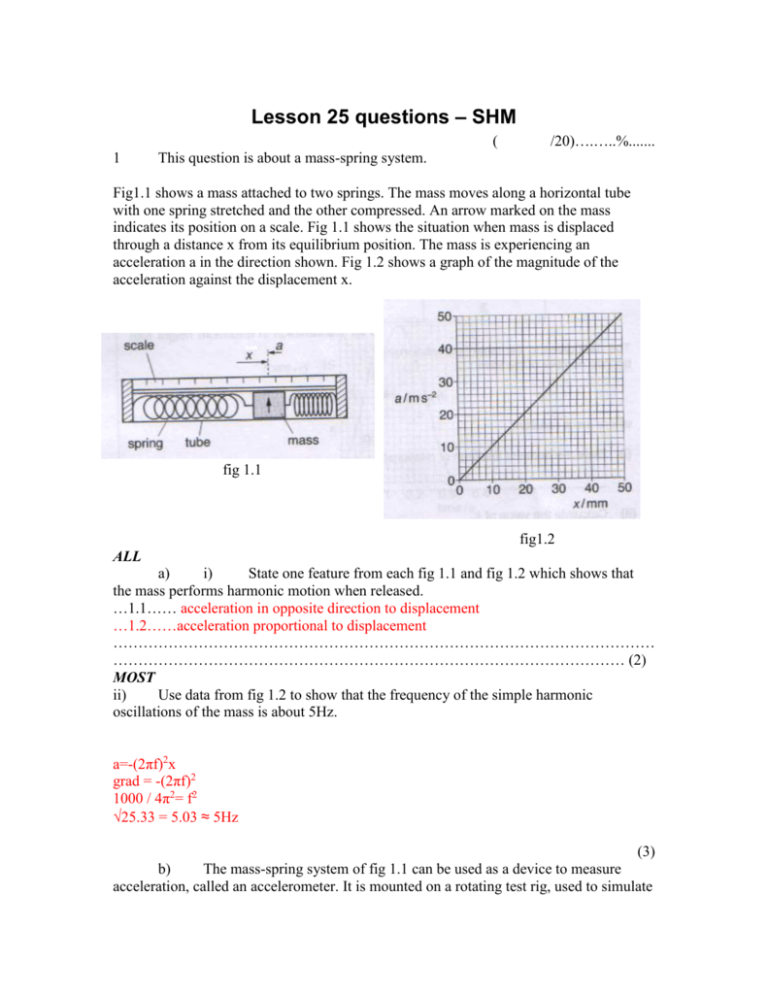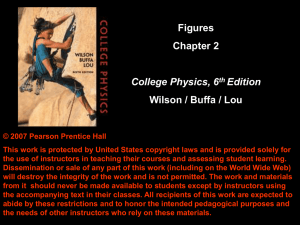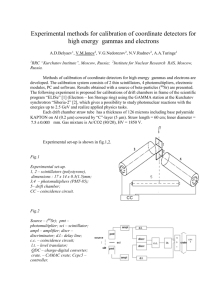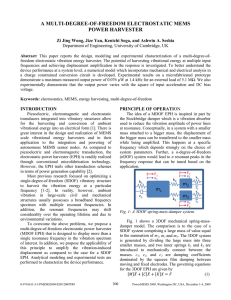answers - science
advertisement

Lesson 25 questions – SHM ( 1 /20)….…..%....... This question is about a mass-spring system. Fig1.1 shows a mass attached to two springs. The mass moves along a horizontal tube with one spring stretched and the other compressed. An arrow marked on the mass indicates its position on a scale. Fig 1.1 shows the situation when mass is displaced through a distance x from its equilibrium position. The mass is experiencing an acceleration a in the direction shown. Fig 1.2 shows a graph of the magnitude of the acceleration against the displacement x. fig 1.1 fig1.2 ALL a) i) State one feature from each fig 1.1 and fig 1.2 which shows that the mass performs harmonic motion when released. …1.1…… acceleration in opposite direction to displacement …1.2……acceleration proportional to displacement ……………………………………………………………………………………………… ………………………………………………………………………………………… (2) MOST ii) Use data from fig 1.2 to show that the frequency of the simple harmonic oscillations of the mass is about 5Hz. a=-(2πf)2x grad = -(2πf)2 1000 / 4π2= f2 25.33 = 5.03 ≈ 5Hz (3) b) The mass-spring system of fig 1.1 can be used as a device to measure acceleration, called an accelerometer. It is mounted on a rotating test rig, used to simulate large g-forces for astronauts. Fig 1.3 shows the plan view of a long beam rotating about its axis A with the astronaut seated at end B, facing towards A. The accelerometer is parallel to the beam and is fixed under the seat 10m from A. fig 1.3 ALL i) When the astronaut is rotating at a constant speed, the arrow marked on the mass has a constant deflection. Explain why. …………At constant angular speed there is a constant centripetal acceleration toward the centre of the circle.……………………………………………………………… ……………………………………………………………………………………………… ……………………………………………………………………………………………… ………………………………………………………………………………………… (2) ii) Calculate the speed v of rotation of the astronaut when the deflection is 50mm. at 50mm a= 50 ms-2 r=10m a=v2/r 500= v2 v = ……22.4…………. ms-1 (2) 2 A bored student (in a biology lesson) holds one end of a flexible plastic ruler against the laboratory bench and flicks the other end, setting the ruler into oscillation. The end of the ruler moves a total distance of 8.0cm as in the diagram and makes 28 complete oscillations in 10s. SOME a) What are the amplitude x0 and frequency f of the motion of the end of the ruler? 28 oscillations in 10 seconds One osc.=10/28 1 oscillation = 0.357s f=1/T x0 = ………0.04…………….. m (1) f = ………2.8…………….. Hz (1) ALL b) Use x= x0cos2πft to produce a table of values of x and t for values: t/s = 0, 0.04, 0.08, 0.12, 0.16, 0.20, 0.24, 0.28, 0.32, 0.36 t/s x/m 0 0.04 0.08 0.12 0.16 0.2 0.24 0.28 0.32 0.36 0 0.03051 0.00653 -0.02054 -0.03787 -0.03722 -0.0189 0.00838 0.03169 0.03996 (4) Draw a graph on the attached graph paper of x against t and use it to find the maximum speed at the end of the ruler. (4) displacement/m q2 0.05 0.04 0.03 0.02 0.01 0 -0.01 0 -0.02 -0.03 -0.04 -0.05 0.1 0.2 0.3 0.4 gradient = 0.7 (+- 0.05) ms-1 time/s











